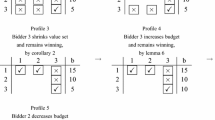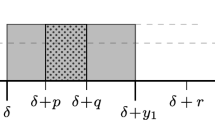Abstract
We consider the problem of truthfully auctioning a single item, that can be either fractionally or probabilistically divided among several winners when their bids are sufficiently close to a tie.
While Myerson’s Lemma states that any monotone allocation rule can be implemented, truthful payments are computed by integrating over each profile, and may be difficult to comprehend and explain. We look for payment rules that are given explicitly as a simple function of the allocated fraction and the others’ bids. For two agents, this simply coincides with (non-negative) Myerson’s payments. For three agents or more, we characterize the near-tie allocation rules that admit such explicit payments, and provide an iterative algorithm to compute them. In particular we show that any such payment rule must require positive payments to some of the bidders.
Access this chapter
Tax calculation will be finalised at checkout
Purchases are for personal use only
Similar content being viewed by others
Notes
- 1.
For a PSA, \(x_{\underline{k}}\) is a step function. In the general case Myerson’s lemma uses an integral over \(x_{\underline{k}}\) rather than a sum.
- 2.
This can be formally implemented, for example, if each agent j reports (in addition to \(b_j\)) a rational number \(r_j\). In case of a tie, we rank the tied agents according to \(R_j:=r_j\cdot \sqrt{\psi _j}\) where \(\psi _j\) is the j’th prime. Note that \(R_j,R_{j'}\) are never tied (since \(\sqrt{\psi _j}\) are linearly independent over the rationals [1]), unbounded on both sides, and that for any \(r_{j'}<r_{j''}\) and j there is \(r_j\) s.t. \(R_{j'}<R_j<R_{j''}\).
- 3.
We do not allow agents for which \(\alpha _j=0\), as they would change the allocation without being affected.
References
Besicovitch, A.S.: On the linear independence of fractional powers of integers. J. London Math. Soc. 15, 3–6 (1940)
Cavallo, R.: Optimal decision-making with minimal waste: strategyproof redistribution of VCG payments. In: Proceedings of the Fifth International Joint Conference on Autonomous Agents and Multiagent Systems, pp. 882–889 (2006)
Clark, D.J., Riis, C.: Influence and the discretionary allocation of several prizes. Eur. J. Polit. Econ. 14(4), 605–625 (1998)
Eden, M.: Optimal ties in contests. Technical report, Hebrew University (2006)
Fiat, A., Goldberg, A.V., Hartline, J.D., Karlin, A.R.: Competitive generalized auctions. In: Proceedings of the Thirty-Fourth Annual ACM Symposium on Theory of Computing, pp. 72–81 (2002)
Fischer, S., Güth, W., Kaplan, T.R., Zultan, R.: Auctions with leaks about early bids: analysis and experimental behavior. Econ. Inq. 59(2), 722–739 (2021)
Gama, J.: Functional trees. Mach. Learn. 55(3), 219–250 (2004). https://doi.org/10.1023/B:MACH.0000027782.67192.13
Graczyk, M., Lasota, T., Trawiński, B.: Comparative analysis of premises valuation models using KEEL, RapidMiner, and WEKA. In: Nguyen, N.T., Kowalczyk, R., Chen, S.-M. (eds.) ICCCI 2009. LNCS (LNAI), vol. 5796, pp. 800–812. Springer, Heidelberg (2009). https://doi.org/10.1007/978-3-642-04441-0_70
Guo, M., Conitzer, V.: Worst-case optimal redistribution of VCG payments in multi-unit auctions. Games Econ. Behav. 67(1), 69–98 (2009)
Hashimoto, K.: Strategy-proof rule in probabilistic allocation problem of an indivisible good and money (2015)
Ivanov, D., Nesterov, A.: Identifying bid leakage in procurement auctions: machine learning approach. In: Proceedings of the 2019 ACM Conference on Economics and Computation, pp. 69–70 (2019)
Lee, J.S., Szymanski, B.K.: A novel auction mechanism for selling time-sensitive e-services. In: Seventh IEEE International Conference on E-Commerce Technology (CEC 2005), pp. 75–82. IEEE (2005)
Li, S.: Obviously strategy-proof mechanisms. Am. Econ. Rev. 107(11), 3257–87 (2017)
Ma, H., Meir, R., Parkes, D.C., Zou, J.: Contingent payment mechanisms for resource utilization. In: Proceedings of the 18th International Conference on Autonomous Agents and MultiAgent Systems, pp. 422–430 (2019)
Milgrom, P.: Simplified mechanisms with an application to sponsored-search auctions. Games Econ. Behav. 70(1), 62–70 (2010)
Morgenstern, J.H., Roughgarden, T.: On the pseudo-dimension of nearly optimal auctions. In: Advances in Neural Information Processing Systems, vol. 28 (2015)
Murillo, J., Muñoz, V., López, B., Busquets, D.: A fair mechanism for recurrent multi-unit auctions. In: Bergmann, R., Lindemann, G., Kirn, S., Pěchouček, M. (eds.) MATES 2008. LNCS (LNAI), vol. 5244, pp. 147–158. Springer, Heidelberg (2008). https://doi.org/10.1007/978-3-540-87805-6_14
Myerson, R.B.: Optimal auction design. Math. Oper. Res. 6(1), 58–73 (1981)
Nedelec, T., El Karoui, N., Perchet, V.: Learning to bid in revenue-maximizing auctions. In: International Conference on Machine Learning, pp. 4781–4789. PMLR (2019)
Núñez, M.: Towards transparent mechanisms. In: Laslier, J.-F., Moulin, H., Sanver, M.R., Zwicker, W.S. (eds.) The Future of Economic Design. SED, pp. 341–346. Springer, Cham (2019). https://doi.org/10.1007/978-3-030-18050-8_47
Ohseto, S.: Characterizations of strategy-proof and fair mechanisms for allocating indivisible goods. Econ. Theor. 29(1), 111–121 (2006). https://doi.org/10.1007/s00199-005-0014-1
Pápai, S.: Groves sealed bid auctions of heterogeneous objects with fair prices. Soc. Choice Welfare 20(3), 371–385 (2003). https://doi.org/10.1007/s003550200185
Quinlan, J.R., et al.: Learning with continuous classes. In: 5th Australian Joint Conference on Artificial Intelligence, vol. 92, pp. 343–348. World Scientific (1992)
Rubinstein, A.: On the computational complexity of optimal simple mechanisms. In: Proceedings of the 2016 ACM Conference on Innovations in Theoretical Computer Science, pp. 21–28 (2016)
Rubinstein, A., Weinberg, S.M.: Simple mechanisms for a subadditive buyer and applications to revenue monotonicity. ACM Trans. Econ. Comput. (TEAC) 6(3–4), 1–25 (2018)
Varian, H.R.: Position auctions. Int. J. Ind. Organ. 25(6), 1163–1178 (2007)
Yengin, D.: Characterizing welfare-egalitarian mechanisms with solidarity when valuations are private information. BE J. Theor. Econ. 12(1) (2012)
Acknowledgement
The authors thank Okke Schijvers and Ella Segev for fruitful discussions.
Author information
Authors and Affiliations
Corresponding author
Editor information
Editors and Affiliations
Rights and permissions
Copyright information
© 2022 The Author(s), under exclusive license to Springer Nature Switzerland AG
About this paper
Cite this paper
Meir, R., Colini-Baldeschi, R. (2022). Explicitly Simple Near-Tie Auctions. In: Kanellopoulos, P., Kyropoulou, M., Voudouris, A. (eds) Algorithmic Game Theory. SAGT 2022. Lecture Notes in Computer Science, vol 13584. Springer, Cham. https://doi.org/10.1007/978-3-031-15714-1_7
Download citation
DOI: https://doi.org/10.1007/978-3-031-15714-1_7
Published:
Publisher Name: Springer, Cham
Print ISBN: 978-3-031-15713-4
Online ISBN: 978-3-031-15714-1
eBook Packages: Computer ScienceComputer Science (R0)




